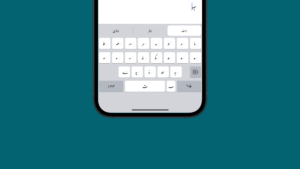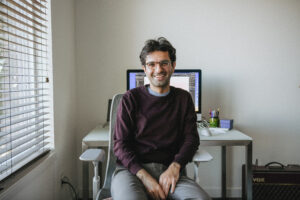
Computing treats non-Latin languages as second-class citizens. Despite efforts, many languages like Urdu remain disproportionately underrepresented on the Internet, in electronic communication, publishing, and software design. The history of Urdu computing in particular is a story of repeatedly compromising linguistic tradition to fit available technology. The result of this history is an inescapable belief in Pakistan today that English is the language of computing – implying that Urdu will never be sufficient for computing.
Of course the reality is that computing is not sufficient for Urdu. Matnsaz is an initiative to build consumer and developer tools for the Urdu language. These tools are built with the outlook to scale to other languages in the Arabic script. The goal is not just to build software, but to help our audience believe that high quality computing can be experienced in Urdu and built by Urdu speakers. We are committed to open-sourcing large parts of our work. We attempt to build an awareness of culture and history into our technology.
Matnsaz began in the Harvard University Design Engineering program, under the University's Graduate School of Design, and the School of Engineering and Applied Sciences. The development of Matnsaz is supported by faculty, members and resources from the Harvard University Department of Computer Science, the Harvard School of Law, the Lahore University of Management Sciences, Al-Mawrid Institute, and IBC Urdu.
Modern technology has been built for Latin script first. Urdu support has been delivered with a spate of compromises that has left us believing that Urdu is not fit for modern computing. The reality is that it is computing that is not sufficient for Urdu.
A Breakthrough New Urdu Keyboard
For too long, typing Urdu has required the use of archaic layouts, shift keys, and bad correction. Modern technology has been built for Latin script first. Urdu support has been delivered with a spate of compromises that has left us believing that Urdu is not fit for modern computing. The reality is that it is computing that is not sufficient for Urdu.
Matnsaz changes this. A rethought keyboard layout uses the layers of the Arabic script itself, to compress a large alphabet into an easy-to-use modern keyboard. This is powered by a state of the art auto-correct system, built on the language of Urdu scholars.

This heralds a new era of Urdu computing. Urdu is written using the Arabic script, which has 3 inherent layers. These layers of rasm, iʿjām and iʿrāb make up all the letters we use every day.
All languages in the Arabic script share the same basic rasms. Using this inherent layering, the Urdu keyboard was compressed from 39 to 21 keys. These are easier to understand and target, for faster learning and more accurate typing.
Arabic script's cursive nature means that each letter changes its shape depending on where it is positioned in the word. When learning the Arabic script, children are taught to think on two layers of abstraction: to identify the letters in their isolated form and then also in the forms they take in words. This is taught using the elementary (disassembly - assembly) exercise.
Each letter can take one of four basic forms: isolated, initial, medial, or final.
Keys that represent the shape characters will take
Representing the keys in the isolated shapes requires more mental effort to find letters on the keyboard, and also makes it hard to debug erroneous text input. As an option Matnsāz allows keys to reflect the shape letters will take, instead of their isolated form.

Autocorrect that learned from the best
Matnsaz is built on top of Makhzan, the highest-quality Urdu language repository. We built Makhzan ourselves, because existing language resources were not good enough. Makhzan sources text from publications with high editorial standards. We painstakingly fixed all errors in this text promulgated by poor software. Then combined it with state-of-the-art natural language processing to build an Urdu autocorrect for the modern age.
Who should use Matnsaz?
For the elderly, the simple layout makes computing in Urdu less daunting. For children, they can learn cursive by seeing upcoming shapes of letters. For writers, Makhzan-powered suggestions enable higher quality composition with speed and teachers can use supportive technology to help new Urdu learners with the nuances of the script and the language.
Meet the brain behind Matnsaz
Zeerak Ahmed is a designer, engineer, and writer. With many years of experience at Amazon.com, Inc and Microsoft Corporation, Zeerak is a renowned design and product leader in the technology industry. He is also known for his cultural work, having been a well-read writer about Pakistani music for over a decade. He currently writes about Pakistani pop on Hamnawa.
He has been invited to speak about Matnsaz at various venues, including the International Design Conference held by the Industrial Designers Society of America, the National Incubation Center at the Lahore University of Management Sciences, and the School of Visual Arts & Design at Beaconhouse National University.
Zeerak frequently lectures in design and computer science at Harvard University, and the Lahore University of Management Sciences. Zeerak holds a Masters in Design Engineering with Distinction from the Harvard Graduate School of Design, and the Harvard School of Engineering & Applied Science, and a Bachelors of Science in Engineering with High Honors in Computer Science & Public Policy from Princeton University.He has also completed coursework at Oxford University, and the Massachusetts Institute of Technology.
https://youtu.be/LqHlCU5itHg
Of course the reality is that computing is not sufficient for Urdu. Matnsaz is an initiative to build consumer and developer tools for the Urdu language. These tools are built with the outlook to scale to other languages in the Arabic script. The goal is not just to build software, but to help our audience believe that high quality computing can be experienced in Urdu and built by Urdu speakers. We are committed to open-sourcing large parts of our work. We attempt to build an awareness of culture and history into our technology.
Matnsaz began in the Harvard University Design Engineering program, under the University's Graduate School of Design, and the School of Engineering and Applied Sciences. The development of Matnsaz is supported by faculty, members and resources from the Harvard University Department of Computer Science, the Harvard School of Law, the Lahore University of Management Sciences, Al-Mawrid Institute, and IBC Urdu.
Modern technology has been built for Latin script first. Urdu support has been delivered with a spate of compromises that has left us believing that Urdu is not fit for modern computing. The reality is that it is computing that is not sufficient for Urdu.
A Breakthrough New Urdu Keyboard
For too long, typing Urdu has required the use of archaic layouts, shift keys, and bad correction. Modern technology has been built for Latin script first. Urdu support has been delivered with a spate of compromises that has left us believing that Urdu is not fit for modern computing. The reality is that it is computing that is not sufficient for Urdu.
Matnsaz changes this. A rethought keyboard layout uses the layers of the Arabic script itself, to compress a large alphabet into an easy-to-use modern keyboard. This is powered by a state of the art auto-correct system, built on the language of Urdu scholars.

This heralds a new era of Urdu computing. Urdu is written using the Arabic script, which has 3 inherent layers. These layers of rasm, iʿjām and iʿrāb make up all the letters we use every day.
All languages in the Arabic script share the same basic rasms. Using this inherent layering, the Urdu keyboard was compressed from 39 to 21 keys. These are easier to understand and target, for faster learning and more accurate typing.
Arabic script's cursive nature means that each letter changes its shape depending on where it is positioned in the word. When learning the Arabic script, children are taught to think on two layers of abstraction: to identify the letters in their isolated form and then also in the forms they take in words. This is taught using the elementary (disassembly - assembly) exercise.
Each letter can take one of four basic forms: isolated, initial, medial, or final.
Keys that represent the shape characters will take
Representing the keys in the isolated shapes requires more mental effort to find letters on the keyboard, and also makes it hard to debug erroneous text input. As an option Matnsāz allows keys to reflect the shape letters will take, instead of their isolated form.

Autocorrect that learned from the best
Matnsaz is built on top of Makhzan, the highest-quality Urdu language repository. We built Makhzan ourselves, because existing language resources were not good enough. Makhzan sources text from publications with high editorial standards. We painstakingly fixed all errors in this text promulgated by poor software. Then combined it with state-of-the-art natural language processing to build an Urdu autocorrect for the modern age.
Who should use Matnsaz?
For the elderly, the simple layout makes computing in Urdu less daunting. For children, they can learn cursive by seeing upcoming shapes of letters. For writers, Makhzan-powered suggestions enable higher quality composition with speed and teachers can use supportive technology to help new Urdu learners with the nuances of the script and the language.
Meet the brain behind Matnsaz
Zeerak Ahmed is a designer, engineer, and writer. With many years of experience at Amazon.com, Inc and Microsoft Corporation, Zeerak is a renowned design and product leader in the technology industry. He is also known for his cultural work, having been a well-read writer about Pakistani music for over a decade. He currently writes about Pakistani pop on Hamnawa.
He has been invited to speak about Matnsaz at various venues, including the International Design Conference held by the Industrial Designers Society of America, the National Incubation Center at the Lahore University of Management Sciences, and the School of Visual Arts & Design at Beaconhouse National University.

Zeerak frequently lectures in design and computer science at Harvard University, and the Lahore University of Management Sciences. Zeerak holds a Masters in Design Engineering with Distinction from the Harvard Graduate School of Design, and the Harvard School of Engineering & Applied Science, and a Bachelors of Science in Engineering with High Honors in Computer Science & Public Policy from Princeton University.He has also completed coursework at Oxford University, and the Massachusetts Institute of Technology.
https://youtu.be/LqHlCU5itHg

